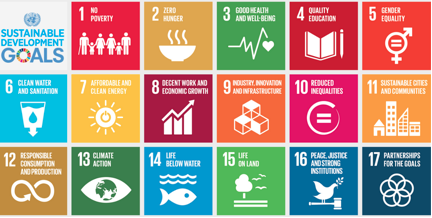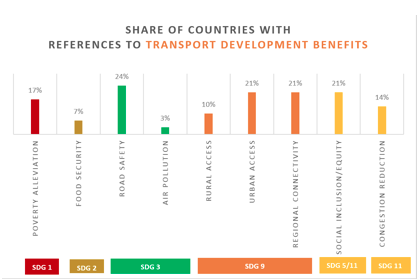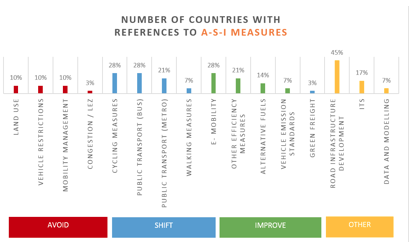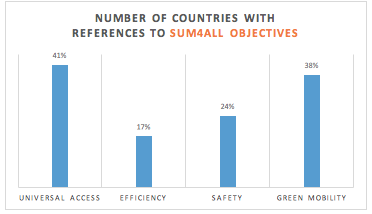2017 Voluntary National Reviews: Limited Focus on the Contribution of Transport toward Realizing the Sustainable Development Goals (Interim Results)
The 2030 Agenda for Sustainable Development is a set of 17 Sustainable Development Goals (SDGs) adopted by world leaders in September 2015 and aimed at stimulating actions to shift the world onto a sustainable and resilient path (Figure 1).
 Figure 1. 17 Sustainable Development Goals of the 2030 Agenda
Figure 1. 17 Sustainable Development Goals of the 2030 Agenda
The High-level Political Forum (HLPF) on Sustainable Development is the United Nations central platform for the follow-up and review of the 2030 Agenda. The HLPF in 2017 will take place from 10 to 19 July under the theme, “Eradicating poverty and promoting prosperity in a changing world.” HLPF will specifically review SDG 1 (No Poverty), SDG 2 (Zero Hunger), SDG 3 (Good Health and Well-being), SDG 5 (Gender Equality), SDG 9 (Industry, Innovation, and Infrastructure) and SDG 14 (Life below Water). For more information on the direct and indirect transport targets of the SDGs, please go to here.
As part of its follow-up and review mechanisms, the 2030 Agenda encourages member states to submit voluntary, state-led, national reports known as Voluntary National Reviews (VNRs) to report on the implementation of the SDGs. 22 VNRs were submitted in 2016 and 44 are going to be presented at the HLPF this year. As of 11 July, 29 VNRs have been submitted.
Following an initial analysis on the treatment of transport in the 22 VNRs submitted in 2016, SLoCaT continues to track the references to transport in the VNRs submitted to HLPF 2017. Only 64% of the 22 VNRs submitted in 2016 contain references to transport, with not all references sustainability-specific. In 2017, 97% of the 29 submitted VNRs have certain degree of references to the transport sector, with around 38% of them giving specific examples and references to link transport with sustainable development impacts.
Key Findings (Interim Results)
1. Despite a slight improvement from 2016, gaps remain in reporting on transport and its contribution to sustainable development in VNRs.
There remains a tendency in many VNRs to merely report on kilometres of highways built or rail constructed without demonstrating linkages to broader development goals. At the same time there is ample evidence of sustainable transport policies and measures in the 2017 VNR countries. It is not fully clear why this progress is not reported in a more substantive manner. In total, only 11 countries (38%) offer considerable information on transport in the context of sustainable development benefits and impacts (Figure 2).

Figure 2. Share of countries with references to transport development benefits
2. Seven countries (25%) use data to illustrate progress made in the transport, but generally with inconsistent formats and levels of detail.
Data to illustrate progress on the transport-related SDGs are provided by few countries, generally with inconsistent formats and levels of detail. For example, some countries, such as Belgium, Peru, and Uruguay, include detailed data profiles for each SDG (although detailed information may not be provided for all SDGs); while other countries, such as Benin and Nigeria, only cite figures for certain SDGs as part of the narrative of the report. Inconsistent data reporting to SDG indicators across the VNRs also shows that the current VNR mechanism lacks the proper structure and framework to guide countries to report in a comparable and coherent manner.
3. Seven countries (24%) include targets for sustainable transport development.
These targets cover GHG emission reduction in the transport sector/ sub-sectors (Portugal and Thailand), road safety (Belgium and Thailand), freight transport (Thailand), energy consumption of the transport sector (Cyprus), public transport (Denmark), cycling and walking (Luxembourg), and electric mobility (the Netherlands, Luxembourg).
4. There is an imbalance between the references to Avoid, Shift, and Improve measures in VNRs.
Countries have been more inclined to identify transport “Shift” measures over “Improve” measures in their VNRs, with “Avoid” measures receiving the least attention (Figure 3). Road infrastructure is a primary example of transport sector expansion for more than 45% of countries, but most of these references are economic and not linked to sustainability issues.
Countries should utilize all three types of measures in order to address transport sustainability issues in a comprehensive manner.

Figure 3. Share of countries with references to A-S-I transport measures
5. There is much greater room to reflect the four objectives of the Sustainable Mobility for All initiative among the VNRs.
The Sustainable Mobility for All (SuM4All) Initiative aims to facilitate the delivery of four primary objectives of sustainable transport, which include Universal Access, Efficiency, Safety, and Green Mobility. Among the four SuM4ALL objectives, Universal Access is mentioned in the greatest number of VNRs, followed by Green Mobility, Safety, and Efficiency (figure 3).

Figure 4. number of countries with references to the SuM4ALL objectives
For more information on the transport references in the VNRs in 2017, please see the full report here.
Supporting matrix on transport references in VNRs
In support of this assessment, SLoCaT has developed a matrix to assess countries’ references to two transport modes, seven transport sub-sectors, and 21 transport policy measures in the VNRs, based on the Avoid-Shift-Improve framework. The assessment also considers whether these transport references are made in relations to nine different sustainability-related impacts, including poverty alleviation, food security, social inclusion and equity, urban access, rural access, regional connectivity, road safety, congestion reduction, and air pollution/ public health. A binary assessment is also made on the references to the four SuM4ALL objectives.
The supporting matrix is available here.